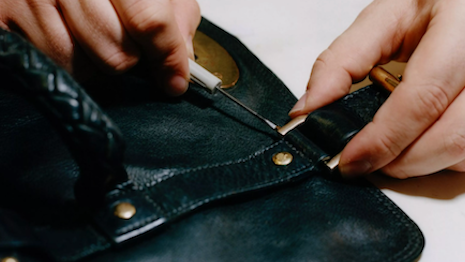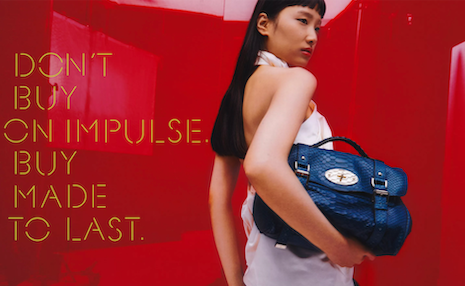 Mulberry looks to source leather sustainably, responsibly managing all parts of the supply chain. Image credit: Mulberry
Mulberry looks to source leather sustainably, responsibly managing all parts of the supply chain. Image credit: Mulberry
British leather goods house Mulberry is committing to achieving a regenerative and circular business model, making the industry more sustainable one handbag at a time.
To commemorate this journey, the brand has launched a new series of low-carbon leather bags, as well as a new restoration edit in partnership with Vestiaire Collective. Through a short film produced by BBC StoryWorks, titled “Can a bag help save the world,” Mulberry explores its mission of blending sustainable innovation with contemporary British design and craftsmanship.
Sustainable leather?
Featuring model and environmental activist Arizona Muse, Mulberry supply chain director Rob Billington and regenerative agriculture specialist Alex Brewster, the five-minute vignette looks at the entire process of fashion and how points along the supply chain can be made more sustainable, from the ground up.
To celebrate its 50th anniversary, while keeping sustainability at the heart of the brand, Mulberry launched its “Made to Last” initiative, which includes a series of actionable commitments for environmental and social change.
The first of those commitments is to become net-zero in carbon emissions by 2035, 15 years ahead of the 2050 deadline set by world leaders.
Mulberry’s sustainability journey is made up of three parts: net-zero carbon, regenerative agriculture, circularity
To achieve this, Mulberry says it must examine its global operations and intends to build a local and transparent “farm to finished product” supply chain, working in tandem with tanneries to develop low-carbon leather sourced from a network of regenerative farms, the second major commitment in its sustainability journey.
By 2030, Mulberry aims to have its entire leather supply chain adhere to this sourcing model.
“We look continuously to reduce our impact on the environment, extend the life of a product and reduce the waste within that life cycle,” Mr. Billington says in the video.
The third commitment hinges on circularity.
In addition to its repairs center, Mulberry introduced an exchange program, in which the brand buys back handbags, refurbishes them through the repairs program and then resells the products.
“We made a bag that is made to last, and can be handed down through generations,” Mr. Billington says. “The province of the product goes way back into the supply chain.”
Through Mulberry Exchange, customers may have their Mulberry bags authenticated and appraised, with the opportunity to put that value towards a new purchase.
 Mulberry Exchange allows customers to appraise their handbags and contribute to a circular fashion economy. Image credit: Mulberry
Mulberry Exchange allows customers to appraise their handbags and contribute to a circular fashion economy. Image credit: Mulberry
The suite of services is available online as well as in Mulberry U.K. stores.
Alternative materials
As sustainability becomes more important to both investors and consumers, leather goods houses with decades of history are beginning to see the potential for a future without animal skins.
British fashion brand Stella McCartney created a set of leather-alternative garments made from lab-grown, vegan mushroom leather. Reflecting its 20-year dedication to being a vegetarian, leather-, skin- and fur-free brand, the company highlighted the world’s first Mylo garments, furthering its partnership with Bolt Threads.
The two products from the collaboration, a black bustier top and utilitarian trousers, are not currently available for sale but are the latest example of what Stella McCartney believes to be the future of its fashion offerings (see story).
French fashion house Hermès also dabbled in the mushroom-based leather space, working in collaboration with California-based biomaterial startup MycoWorks. The companies reworked handbags in canvas, calfskin and Sylvania material, an alternative hybrid textile made from mycoWorks’ fine mycelium (see story).
Italian fashion label Gucci also introduced an animal-free, plant-based material, Demetra, which is described as a soft, durable, pliable and supple luxury material (see story).